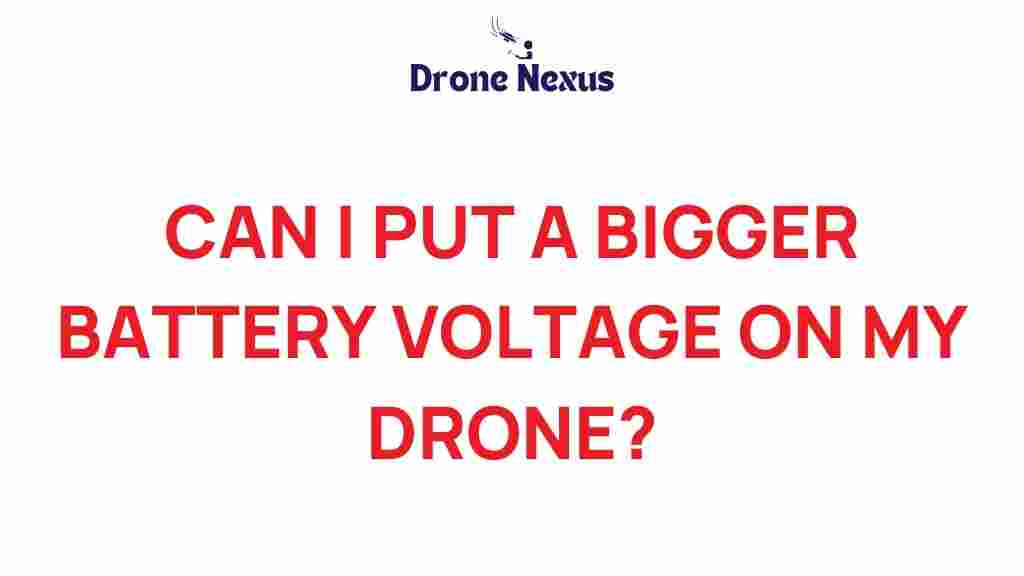Exploring the Risks: Can You Safely Increase Your Drone’s Battery Voltage?
As drone technology continues to advance, enthusiasts and professionals alike are constantly looking for ways to enhance performance. One common question among drone users is whether it’s possible to safely increase their drone battery voltage. While the idea of extending flight times and boosting power is enticing, doing so comes with its own set of risks. In this article, we will explore the implications of increasing your drone’s battery voltage, the step-by-step process to do it safely, troubleshooting tips, and important considerations to keep in mind.
Understanding Drone Batteries
Before diving into the intricacies of battery voltage, it’s crucial to understand the different types of drone batteries available:
- Lithium Polymer (LiPo): Most common in drones due to their high energy density and lightweight nature.
- Lithium-ion: Typically used in larger drones, offering longer life cycles but less power density.
- NiMH (Nickel Metal Hydride): Less common, heavier, and less efficient compared to LiPo batteries.
Each type has its own specifications, and altering those can lead to various issues, including decreased performance and potential hazards. Understanding these differences is the first step in deciding whether to modify your drone’s battery voltage.
Can You Increase Your Drone’s Battery Voltage?
In simple terms, yes, you can increase your drone’s battery voltage. However, the process is fraught with risks. Increasing voltage can lead to improved performance, such as:
- Longer flight times
- Higher speeds
- Improved lifting capacity
Nonetheless, these benefits come at a cost. Higher voltage can result in:
- Overheating components
- Shortened battery life
- Increased risk of crashes due to instability
It’s essential to weigh these risks against the potential benefits before proceeding with any modifications.
Step-by-Step Process to Increase Battery Voltage
If you decide to go ahead with increasing your drone battery voltage, follow these steps to do it as safely as possible:
Step 1: Research and Understand Your Drone’s Specifications
Before making any changes, you should know the voltage specifications for your drone. Check:
- The original drone battery voltage
- The Maximum Voltage input of the drone
- Your drone’s Electronic Speed Controller (ESC) specifications
Refer to the manufacturer’s manual for detailed information.
Step 2: Choose the Right Battery
Once you have a solid understanding of your drone’s specifications, it’s time to choose a suitable battery. Look for batteries that:
- Are designed for your drone model
- Comply with the voltage increase you wish to implement
- Have a reputable brand and positive reviews
Step 3: Modify the Battery Connection
To increase the voltage, you may need to modify the battery connection. This should only be done if you are confident in your electrical skills. Some modifications include:
- Changing connectors
- Reconfiguring the battery cells
Ensure that you are using proper soldering techniques and tools to avoid damaging the battery.
Step 4: Monitor the Performance
After making modifications, it’s crucial to monitor your drone’s performance closely. Keep an eye on:
- Flight time
- Temperature of the battery and drone components
- Behavior during flight (stability, responsiveness)
If you notice any unusual signs, consider reverting to the original voltage.
Troubleshooting Tips
Even after careful modifications, you may encounter issues. Here are some troubleshooting tips for common problems:
Overheating
If your drone battery or components are overheating, consider:
- Reducing the voltage or flight duration
- Improving airflow around the battery
- Using a heat sink on critical components
Decreased Flight Stability
Flight instability can be a sign that the modifications have affected your drone’s balance. To fix this:
- Check that all components are securely mounted
- Adjust the center of gravity by repositioning components
- Re-calibrate the drone’s sensors
Shortened Battery Life
If the battery life has significantly decreased, it might be due to:
- Excessive voltage leading to cell damage
- Improper battery management
- Using a battery not rated for your modifications
Consider reverting to the original battery specifications or investing in a high-quality battery designed for higher voltage.
Important Considerations
Before you decide to increase your drone’s battery voltage, keep the following points in mind:
- Warranty: Modifying your drone may void its warranty. Ensure that you understand the implications.
- Legal Regulations: Check local regulations regarding drone modifications, as they may be subject to legal restrictions.
- Safety: Always prioritize safety. Use protective gear when handling batteries and follow proper disposal methods for damaged batteries.
For more information about drone safety and regulations, visit the FAA’s official site for guidelines.
Conclusion
Increasing your drone’s battery voltage can be a tempting way to enhance performance, but it is not without significant risks. By understanding your drone’s specifications, carefully selecting and modifying your drone battery, and following troubleshooting tips, you can navigate this complex process. Ultimately, the decision to modify your drone should be made with careful consideration of the potential benefits and risks involved. Always prioritize safety and ensure that you are complying with legal requirements. For more drone-related tips and tricks, check out our other articles here.
This article is in the category Safety and created by DroneNexus Team
